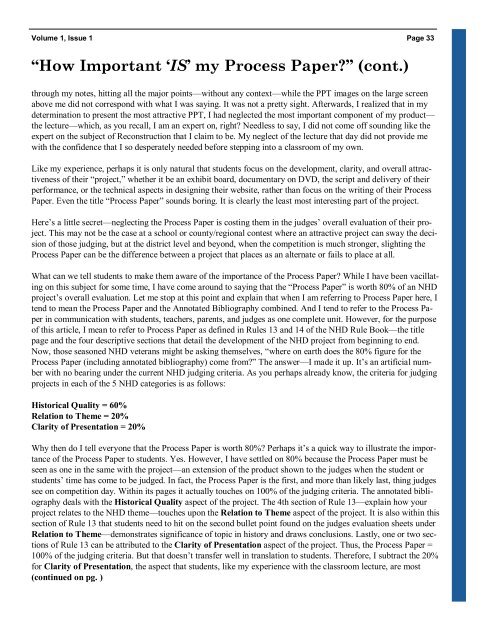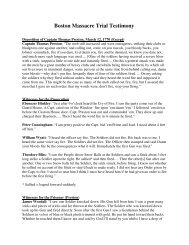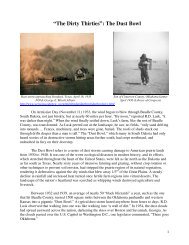Volume 1, Issue 1 - Teach American History
Volume 1, Issue 1 - Teach American History
Volume 1, Issue 1 - Teach American History
Create successful ePaper yourself
Turn your PDF publications into a flip-book with our unique Google optimized e-Paper software.
<strong>Volume</strong> 1, <strong>Issue</strong> 1<br />
“How Important ‘IS’ my Process Paper?” (cont.)<br />
through my notes, hitting all the major points—without any context—while the PPT images on the large screen<br />
above me did not correspond with what I was saying. It was not a pretty sight. Afterwards, I realized that in my<br />
determination to present the most attractive PPT, I had neglected the most important component of my product—<br />
the lecture—which, as you recall, I am an expert on, right? Needless to say, I did not come off sounding like the<br />
expert on the subject of Reconstruction that I claim to be. My neglect of the lecture that day did not provide me<br />
with the confidence that I so desperately needed before stepping into a classroom of my own.<br />
Like my experience, perhaps it is only natural that students focus on the development, clarity, and overall attractiveness<br />
of their “project,” whether it be an exhibit board, documentary on DVD, the script and delivery of their<br />
performance, or the technical aspects in designing their website, rather than focus on the writing of their Process<br />
Paper. Even the title “Process Paper” sounds boring. It is clearly the least most interesting part of the project.<br />
Here’s a little secret—neglecting the Process Paper is costing them in the judges’ overall evaluation of their project.<br />
This may not be the case at a school or county/regional contest where an attractive project can sway the decision<br />
of those judging, but at the district level and beyond, when the competition is much stronger, slighting the<br />
Process Paper can be the difference between a project that places as an alternate or fails to place at all.<br />
What can we tell students to make them aware of the importance of the Process Paper? While I have been vacillating<br />
on this subject for some time, I have come around to saying that the “Process Paper” is worth 80% of an NHD<br />
project’s overall evaluation. Let me stop at this point and explain that when I am referring to Process Paper here, I<br />
tend to mean the Process Paper and the Annotated Bibliography combined. And I tend to refer to the Process Paper<br />
in communication with students, teachers, parents, and judges as one complete unit. However, for the purpose<br />
of this article, I mean to refer to Process Paper as defined in Rules 13 and 14 of the NHD Rule Book—the title<br />
page and the four descriptive sections that detail the development of the NHD project from beginning to end.<br />
Now, those seasoned NHD veterans might be asking themselves, “where on earth does the 80% figure for the<br />
Process Paper (including annotated bibliography) come from?” The answer—I made it up. It’s an artificial number<br />
with no bearing under the current NHD judging criteria. As you perhaps already know, the criteria for judging<br />
projects in each of the 5 NHD categories is as follows:<br />
Historical Quality = 60%<br />
Relation to Theme = 20%<br />
Clarity of Presentation = 20%<br />
Page 33<br />
Why then do I tell everyone that the Process Paper is worth 80%? Perhaps it’s a quick way to illustrate the importance<br />
of the Process Paper to students. Yes. However, I have settled on 80% because the Process Paper must be<br />
seen as one in the same with the project—an extension of the product shown to the judges when the student or<br />
students’ time has come to be judged. In fact, the Process Paper is the first, and more than likely last, thing judges<br />
see on competition day. Within its pages it actually touches on 100% of the judging criteria. The annotated bibliography<br />
deals with the Historical Quality aspect of the project. The 4th section of Rule 13—explain how your<br />
project relates to the NHD theme—touches upon the Relation to Theme aspect of the project. It is also within this<br />
section of Rule 13 that students need to hit on the second bullet point found on the judges evaluation sheets under<br />
Relation to Theme—demonstrates significance of topic in history and draws conclusions. Lastly, one or two sections<br />
of Rule 13 can be attributed to the Clarity of Presentation aspect of the project. Thus, the Process Paper =<br />
100% of the judging criteria. But that doesn’t transfer well in translation to students. Therefore, I subtract the 20%<br />
for Clarity of Presentation, the aspect that students, like my experience with the classroom lecture, are most<br />
(continued on pg. )






